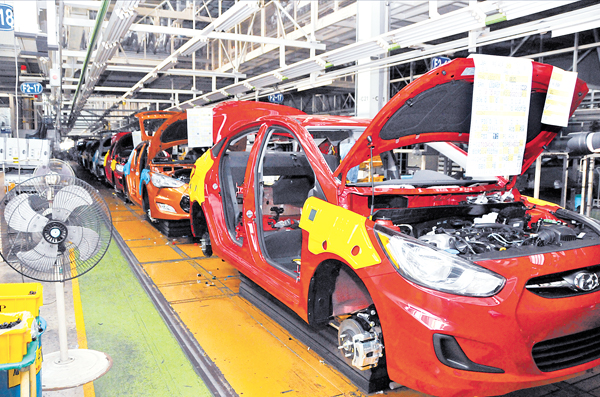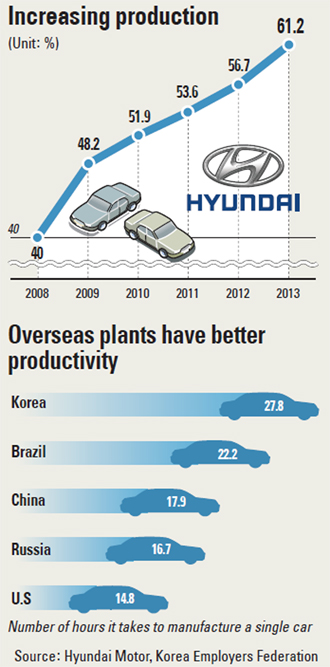Hyundai now resilient to strikes

Hyundai Motor’s production plant in Ulsan, where the Accent is manufactured. [NEWS1]
If the strike lasts until the end of this week, the automaker is expected to suffer a production delay of 5,400 units, which would translate to 110 billion won ($108 million) in losses.
The two sides are at a standoff over wage negotiations for nearly the 30th year in a row.
Despite the union’s decision to up its striking hours, the value of the automaker’s stock rose 1.3 percent on Thursday, marking the fifth consecutive day of increases for the company’s stock price.

Last year, like this year, the stock value of Hyundai Motor rose 4.1 percent even when workers were on a strike. A similar increase occurred in 2012.
Some brokers even advise their clients to purchase stocks when the automaker is in the middle of a strike.
It seems that the strike card that the labor union has been playing so long is wearing thin.
Until recent years, negotiations between the union and management of the company went as follows: the union representatives make an overbearing demand; management refuses; the union goes on strike; the company accepts.
Due to the annual strikes, factory workers at Hyundai Motor are well paid, with an average annual salary of roughly 100 million won a year.
But now the tides are turning against the workers as strikes have become less effective.
Hyundai Motor’s automobile production has grown from 2.8 million units in 2008 to 4.8 million last year, an increase of more than 70 percent. Adding in automobile production at its main affiliate Kia Motors, the automaker’s overall production is more than eight million units a year.
And during the same period, production at its overseas plants has grown significantly. In 2008, production of vehicles overseas only accounted for 40 percent. That figure had risen to 61 percent last year.
So even if the automaker’s production line stops due to the walkout, Hyundai wouldn’t see a significant dent in its overall production, as cars will continue to roll out from its plants spanning from China and Brazil to the United States.
“The chronic strike [by Korean union workers] has given Hyundai Motor the perfect excuse to construct overseas plants and therefore completely changed the company’s production structure,” said Nam Kyung-moon, an analyst at Tongyang Securities.
Hyundai Motor’s tolerance to other negative factors has also improved. In the second quarter, the automaker reported an operating profit rate of 9.2 percent. This means that when selling a product for 100 won, it would take in 9 won of profit.
The only other major automakers that reported better operating profit rates were BMW with 13.1 percent and Toyota with 10.8 percent. Hyundai managed to keep its operating profit rate high despite the strong won.
BY kim young-hoon, kim hyun-ye [ojlee82@joongang.co.kr]










with the Korea JoongAng Daily
To write comments, please log in to one of the accounts.
Standards Board Policy (0/250자)